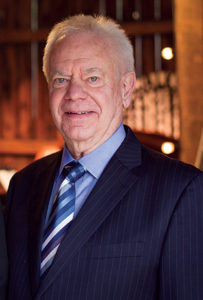 “Fairy Tales and Ghosts.” Our upcoming program that includes music of Beethoven, Schumann, and Haydn seems pregnant with story lines. This is true but maybe with more wrinkles than meet the eye. The Fairy Tales part comes from a work by the same title (Märchenerzählungen) by Robert Schumann written in 1853. It would turn out to be one of his last works just before he threw himself off of a bridge into the Rhine in an apparent suicide attempt. He was rescued by fishermen and then was self-admitted to a mental sanitorium where he spent his last two years. Schumann gives us no specific indications of fairy tale references in the music. We are left to our own resources to conjure up any images or narrative. However, it is suggestive, evocative music, and Schumann brings back several motifs over the four varying movements of the work. We do know that Schumann explored fairy tale stories in other works and particularly liked to think of “characters” in his works, sometimes even having them “converse,” musically speaking, with each other. This was a novel trait of the burgeoning romantic movement in music, and Schumann was one of its primary leaders. His wife Clara wrote in her diary shortly after this work was completed that, “He thinks that this compilation will appear highly romantic.” It might be noted that the Grimm brothers published a children’s edition of their fairy tales from 1825 to 1858, so this was fertile ground for Schumann. It is also noteworthy that the 20-year-old Brahms had appeared at the door of the Schumann residence not long before this composition appeared and ended up living with them, and Robert’s enthusiasm over the youthful talent and virtuosity of the young Brahms may have inspired Robert to generate this valedictory work.
“Fairy Tales and Ghosts.” Our upcoming program that includes music of Beethoven, Schumann, and Haydn seems pregnant with story lines. This is true but maybe with more wrinkles than meet the eye. The Fairy Tales part comes from a work by the same title (Märchenerzählungen) by Robert Schumann written in 1853. It would turn out to be one of his last works just before he threw himself off of a bridge into the Rhine in an apparent suicide attempt. He was rescued by fishermen and then was self-admitted to a mental sanitorium where he spent his last two years. Schumann gives us no specific indications of fairy tale references in the music. We are left to our own resources to conjure up any images or narrative. However, it is suggestive, evocative music, and Schumann brings back several motifs over the four varying movements of the work. We do know that Schumann explored fairy tale stories in other works and particularly liked to think of “characters” in his works, sometimes even having them “converse,” musically speaking, with each other. This was a novel trait of the burgeoning romantic movement in music, and Schumann was one of its primary leaders. His wife Clara wrote in her diary shortly after this work was completed that, “He thinks that this compilation will appear highly romantic.” It might be noted that the Grimm brothers published a children’s edition of their fairy tales from 1825 to 1858, so this was fertile ground for Schumann. It is also noteworthy that the 20-year-old Brahms had appeared at the door of the Schumann residence not long before this composition appeared and ended up living with them, and Robert’s enthusiasm over the youthful talent and virtuosity of the young Brahms may have inspired Robert to generate this valedictory work.
With Beethoven’s “Ghost” Trio, the story is a bit different. The title is not one from Beethoven, although he left references that came to suggest it. Around the time he wrote this trio, he was also contemplating an opera based on Shakespeare’s Macbeth. Sketches for the slow movement include suggestions that this music (including the word, “Macbett”) was also possibly being considered for the “witches dance” in his contemplated opera. Regardless, it is this slow movement that prompted one of Beethoven’s students, the well-known piano virtuoso and composer Carl Czerny to suggest the title because it reminded him of the ghost of Hamlet’s father. Czerny sensed the wrong Shakespeare, but the title stuck. Beethoven achieves this eeriness with a variety of techniques including some very soft playing, strange pauses, otherworldly harmonies, chromaticism, and tremolando. No one had ever heard such a thing before, and it helped change the idea of what music could do. The outer movements are completely different in their more upbeat quality, but this only emphasizes the spookiness of this “ghostly” middle movement. Incidentally, the fine 19th century violinist, composer, and conductor Ludwig Spohr visited Beethoven in his home and was treated to an impromptu performance of this newly minted trio with Beethoven at the piano. Unfortunately, the once-great pianist, now virtually totally deaf, made such a hash of his own work, Spohr could really not get any true sense of it and left feeling great sadness at Beethoven’s now wretched condition.
In the case of the Haydn Trio, the story isn’t one of otherworldliness, it is one of real worldliness. Haydn and the ladies, to be specific. Haydn was married as a young man in 1760. It was a very unhappy union, and Haydn and his wife spent most of their lives apart. Divorce in those days was not an option. So, when Haydn made his two trips to London in the early 1790s, he was the living the life of a single man, now in his early 60s, as he had most of his life. By this time, he had become very well-known and was quite the London celebrity. Haydn had to carefully restrict his social time because he needed to work, but he managed to make exceptions for two different women over time. Both of these women appear to have been inspirations for Piano Trios that Haydn wrote when in London. One of them, Rebecca Schroeter, wrote about their evening together, “…my heart WAS and is full of TENDERNESS for you, but no language can express HALF the LOVE and AFFECTION I feel for you, you are DEARER to me EVERY DAY of my life…”. The Trio in C Major that we are performing was written for Therese Bartolozzi, a very accomplished pianist who had studied with the great piano virtuoso Muzio Clementi. Haydn, who practically invented the Piano Trio as a genre, as he did with the symphony and string quartet, takes his genius to new levels in these works, thanks perhaps to the inspiration of these very interesting women.
Beethoven was keenly aware of what Haydn had accomplished in his string trios, so when he took up that mantle to embark on his “Ghost” Trio, he felt as if Haydn were looking over his shoulder. It pushed him to find his own unique expression. Likewise, Schumann employs the unusual combination of Clarinet, Viola, and Piano favored by Mozart in his Kegelstatt Trio. It seems that, in a way, both Schumann and Beethoven had ghosts hovering over them.
You can come mingle with these spirits at concerts starting on Friday, July 5th, at Shepherd of the Bay Lutheran Church in Ellison Bay, Saturday, July 6th, at the Kress Pavilion in Egg Harbor, and Sunday, July 7th, in Sturgeon Bay at Hope Church. Concerts are at 7:00pm except for Hope, which is at 5:00. For tickets or more information, please call (920) 854-7088 or visit www.midsummersmusic.com. I hope the spirit moves you, and we will see you in person (unless you come as an apparition).
Jim Berkenstock
Artistic Director
